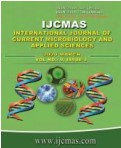


 National Academy of Agricultural Sciences (NAAS)
National Academy of Agricultural Sciences (NAAS)

|
PRINT ISSN : 2319-7692
Online ISSN : 2319-7706 Issues : 12 per year Publisher : Excellent Publishers Email : editorijcmas@gmail.com / submit@ijcmas.com Editor-in-chief: Dr.M.Prakash Index Copernicus ICV 2018: 95.39 NAAS RATING 2020: 5.38 |
Genetic variability, heritability and correlation at genotypic and phenotypic levels and path analysis were studied for various yield and its component characters in seventy five S6 progenies along with five checks of fennel (Foeniculum vulgare Mill.) during Rabi, 2009-10. Analysis of variance revealed significant difference for all the characters indicating the presence of good amount of variability in the S6 progenies studied. The estimates of GCV along with PCV, heritability and genetic advance as percentage of mean were higher for seed yield per plant. The range and coefficient of variation indicated that the variability and genetic advance as percentage of mean was high for seed yield per plant (g), umbels per plant, seeds per umbel and umbellets per umbel. Moderate variability was found for branches per plant and plant height (cm). Low variability was observed for 1000-seed weight (g) and days to 50% flowering. Correlation studies revealed that seed yield per plant was positively and significantly associated with branches per plant, umbels per plant, seeds per umbel, 1000- seed weight and umbellets per umbel and showed negatively significant correlation with days to 50% flowering. Path coefficient analysis revealed that umbels per plant had highest positive direct effect on seed yield per plant followed by seeds per umbel, branches per plant, umbellets per umbel and 1000- seed weight. Based upon the present experiment, it is suggested that in breeding programmes major emphasis should be given to umbels per plant, seeds per umbel, branches per plant, umbellets per umbel and 1000-seed weight as these had positive correlation with seed yield with high direct effect. The Result suggested that exploitation of these S6 progenies suitable for selection and breeding methodology to be adopted to develop high yielding types.
 |
 |
 |
 |
 |